HSYP807: Public Health - Innovation in Leadership and Advocacy Report
VerifiedAdded on 2023/06/10
|12
|3276
|84
Report
AI Summary
This report, addressing the HSYP807 unit on Innovation in Leadership, Teamwork & Advocacy, delves into the core concepts of public health. Part A differentiates between leadership and management, emphasizing the importance of public health advocacy, distinguishing it from lobbying, and evaluating advocacy strategies. Part B presents a real-world scenario, analyzing team dynamics, the impact of alcohol advertising, and challenges in implementing policy changes, such as restricting alcohol ads during sporting events. The report emphasizes the need for evidence-based strategies, stakeholder engagement, and understanding the multifaceted nature of public health issues, providing a comprehensive overview of leadership, teamwork, and advocacy in the context of health promotion and policy influence.
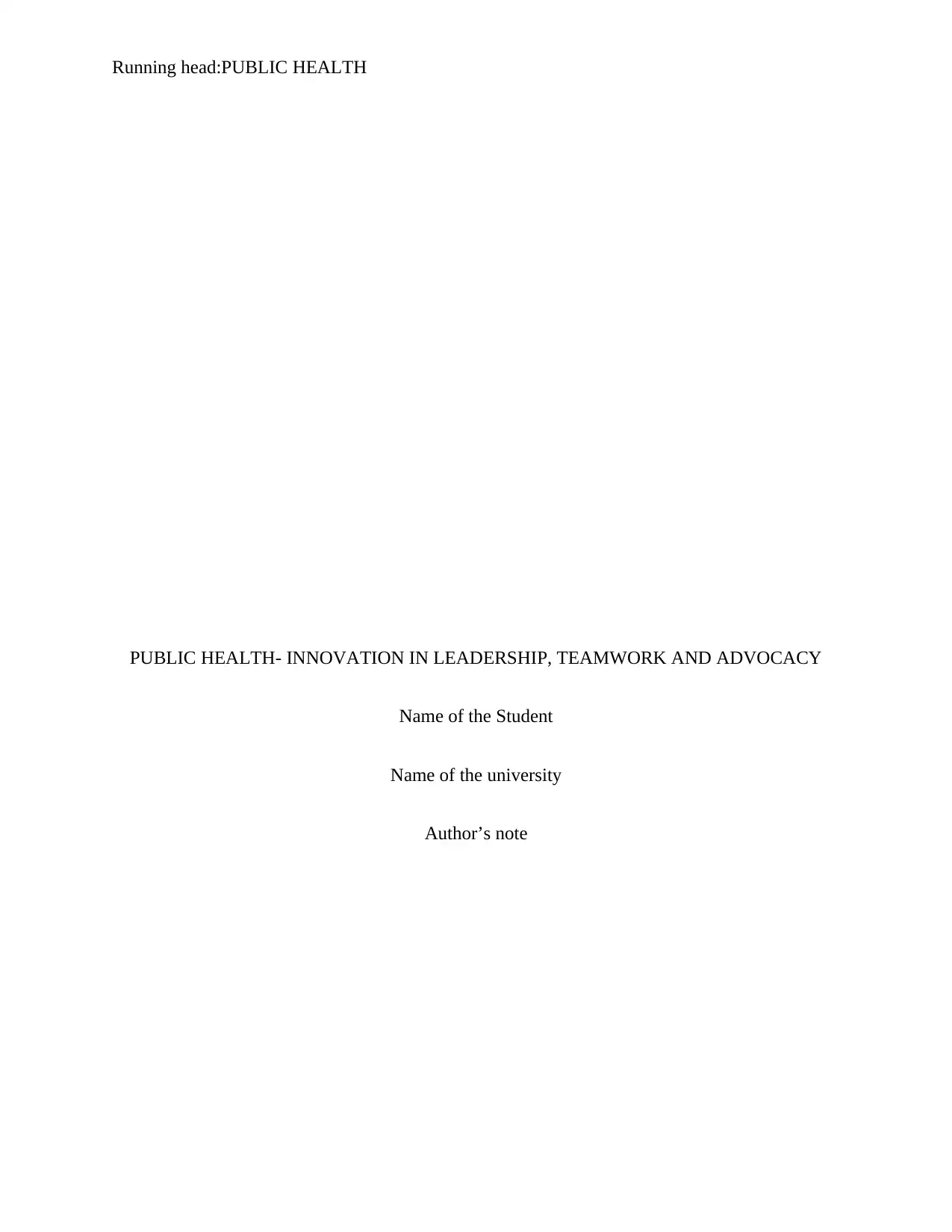
Running head:PUBLIC HEALTH
PUBLIC HEALTH- INNOVATION IN LEADERSHIP, TEAMWORK AND ADVOCACY
Name of the Student
Name of the university
Author’s note
PUBLIC HEALTH- INNOVATION IN LEADERSHIP, TEAMWORK AND ADVOCACY
Name of the Student
Name of the university
Author’s note
Paraphrase This Document
Need a fresh take? Get an instant paraphrase of this document with our AI Paraphraser
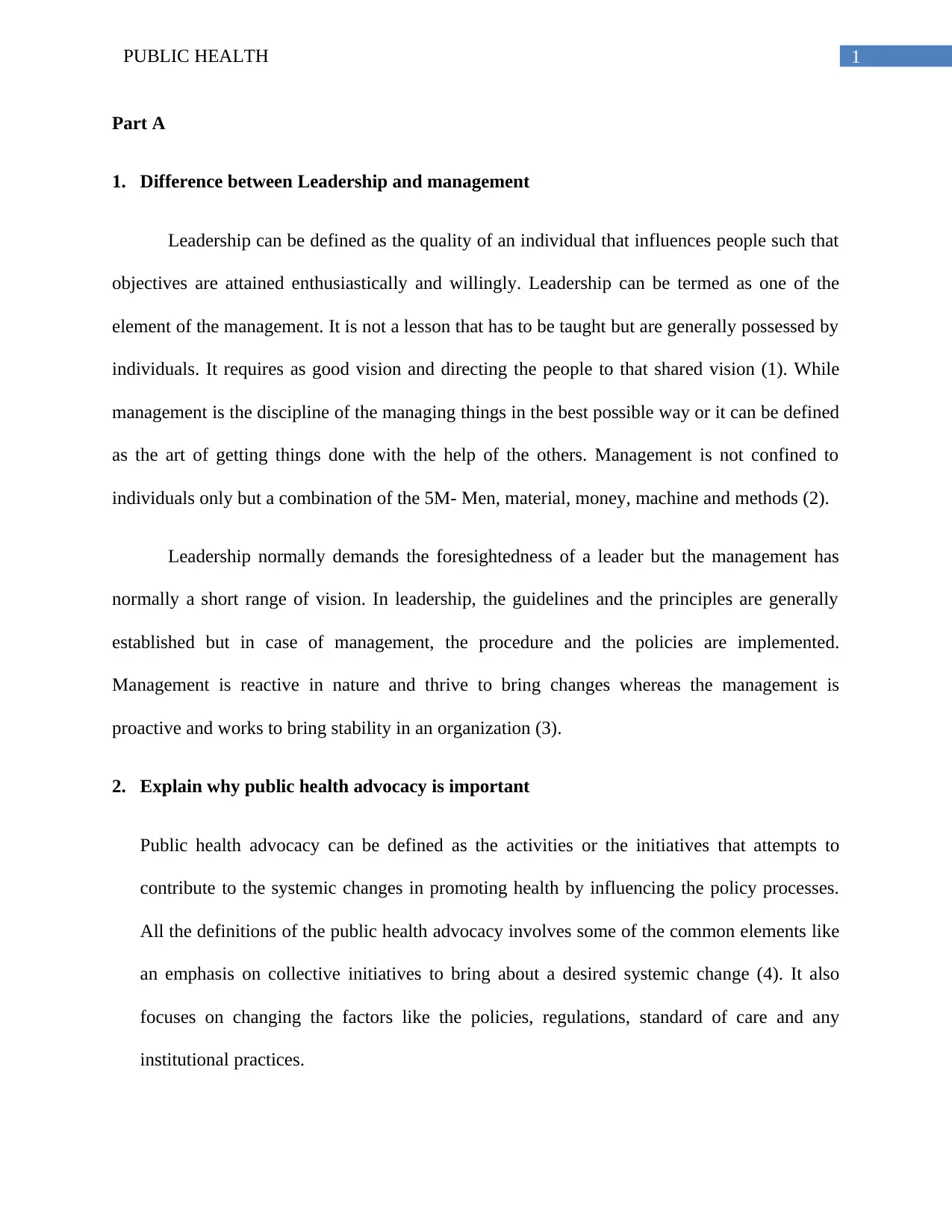
1PUBLIC HEALTH
Part A
1. Difference between Leadership and management
Leadership can be defined as the quality of an individual that influences people such that
objectives are attained enthusiastically and willingly. Leadership can be termed as one of the
element of the management. It is not a lesson that has to be taught but are generally possessed by
individuals. It requires as good vision and directing the people to that shared vision (1). While
management is the discipline of the managing things in the best possible way or it can be defined
as the art of getting things done with the help of the others. Management is not confined to
individuals only but a combination of the 5M- Men, material, money, machine and methods (2).
Leadership normally demands the foresightedness of a leader but the management has
normally a short range of vision. In leadership, the guidelines and the principles are generally
established but in case of management, the procedure and the policies are implemented.
Management is reactive in nature and thrive to bring changes whereas the management is
proactive and works to bring stability in an organization (3).
2. Explain why public health advocacy is important
Public health advocacy can be defined as the activities or the initiatives that attempts to
contribute to the systemic changes in promoting health by influencing the policy processes.
All the definitions of the public health advocacy involves some of the common elements like
an emphasis on collective initiatives to bring about a desired systemic change (4). It also
focuses on changing the factors like the policies, regulations, standard of care and any
institutional practices.
Part A
1. Difference between Leadership and management
Leadership can be defined as the quality of an individual that influences people such that
objectives are attained enthusiastically and willingly. Leadership can be termed as one of the
element of the management. It is not a lesson that has to be taught but are generally possessed by
individuals. It requires as good vision and directing the people to that shared vision (1). While
management is the discipline of the managing things in the best possible way or it can be defined
as the art of getting things done with the help of the others. Management is not confined to
individuals only but a combination of the 5M- Men, material, money, machine and methods (2).
Leadership normally demands the foresightedness of a leader but the management has
normally a short range of vision. In leadership, the guidelines and the principles are generally
established but in case of management, the procedure and the policies are implemented.
Management is reactive in nature and thrive to bring changes whereas the management is
proactive and works to bring stability in an organization (3).
2. Explain why public health advocacy is important
Public health advocacy can be defined as the activities or the initiatives that attempts to
contribute to the systemic changes in promoting health by influencing the policy processes.
All the definitions of the public health advocacy involves some of the common elements like
an emphasis on collective initiatives to bring about a desired systemic change (4). It also
focuses on changing the factors like the policies, regulations, standard of care and any
institutional practices.
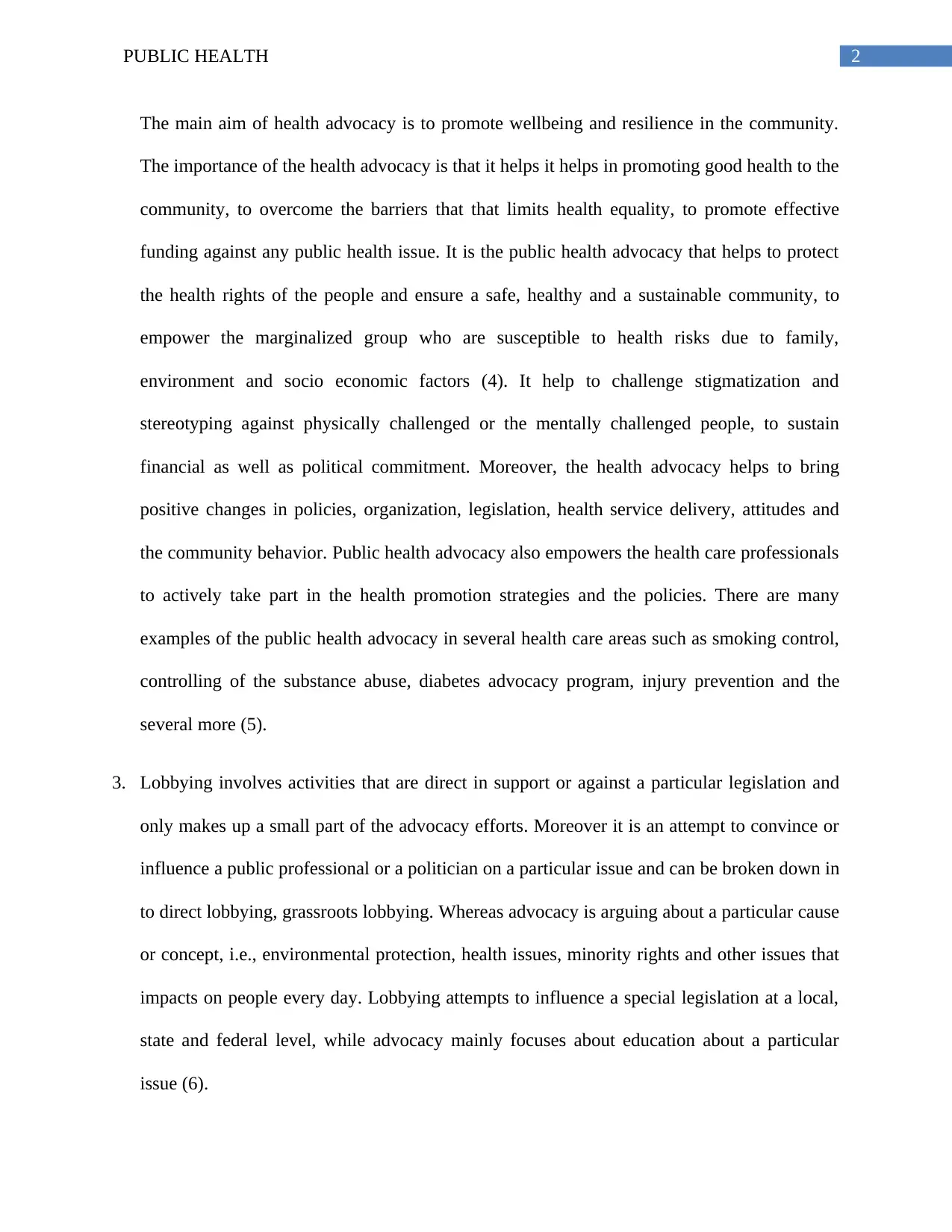
2PUBLIC HEALTH
The main aim of health advocacy is to promote wellbeing and resilience in the community.
The importance of the health advocacy is that it helps it helps in promoting good health to the
community, to overcome the barriers that that limits health equality, to promote effective
funding against any public health issue. It is the public health advocacy that helps to protect
the health rights of the people and ensure a safe, healthy and a sustainable community, to
empower the marginalized group who are susceptible to health risks due to family,
environment and socio economic factors (4). It help to challenge stigmatization and
stereotyping against physically challenged or the mentally challenged people, to sustain
financial as well as political commitment. Moreover, the health advocacy helps to bring
positive changes in policies, organization, legislation, health service delivery, attitudes and
the community behavior. Public health advocacy also empowers the health care professionals
to actively take part in the health promotion strategies and the policies. There are many
examples of the public health advocacy in several health care areas such as smoking control,
controlling of the substance abuse, diabetes advocacy program, injury prevention and the
several more (5).
3. Lobbying involves activities that are direct in support or against a particular legislation and
only makes up a small part of the advocacy efforts. Moreover it is an attempt to convince or
influence a public professional or a politician on a particular issue and can be broken down in
to direct lobbying, grassroots lobbying. Whereas advocacy is arguing about a particular cause
or concept, i.e., environmental protection, health issues, minority rights and other issues that
impacts on people every day. Lobbying attempts to influence a special legislation at a local,
state and federal level, while advocacy mainly focuses about education about a particular
issue (6).
The main aim of health advocacy is to promote wellbeing and resilience in the community.
The importance of the health advocacy is that it helps it helps in promoting good health to the
community, to overcome the barriers that that limits health equality, to promote effective
funding against any public health issue. It is the public health advocacy that helps to protect
the health rights of the people and ensure a safe, healthy and a sustainable community, to
empower the marginalized group who are susceptible to health risks due to family,
environment and socio economic factors (4). It help to challenge stigmatization and
stereotyping against physically challenged or the mentally challenged people, to sustain
financial as well as political commitment. Moreover, the health advocacy helps to bring
positive changes in policies, organization, legislation, health service delivery, attitudes and
the community behavior. Public health advocacy also empowers the health care professionals
to actively take part in the health promotion strategies and the policies. There are many
examples of the public health advocacy in several health care areas such as smoking control,
controlling of the substance abuse, diabetes advocacy program, injury prevention and the
several more (5).
3. Lobbying involves activities that are direct in support or against a particular legislation and
only makes up a small part of the advocacy efforts. Moreover it is an attempt to convince or
influence a public professional or a politician on a particular issue and can be broken down in
to direct lobbying, grassroots lobbying. Whereas advocacy is arguing about a particular cause
or concept, i.e., environmental protection, health issues, minority rights and other issues that
impacts on people every day. Lobbying attempts to influence a special legislation at a local,
state and federal level, while advocacy mainly focuses about education about a particular
issue (6).
⊘ This is a preview!⊘
Do you want full access?
Subscribe today to unlock all pages.

Trusted by 1+ million students worldwide
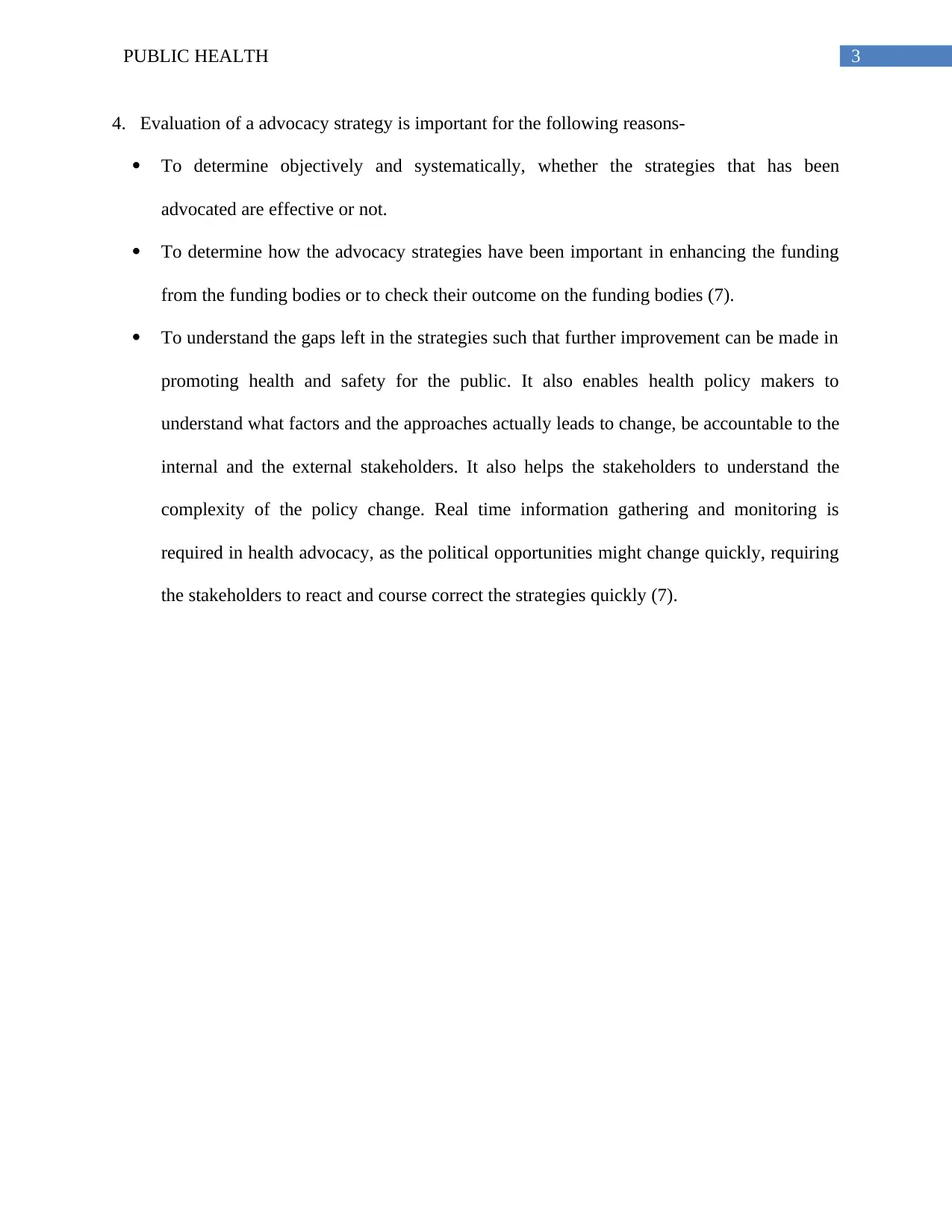
3PUBLIC HEALTH
4. Evaluation of a advocacy strategy is important for the following reasons-
To determine objectively and systematically, whether the strategies that has been
advocated are effective or not.
To determine how the advocacy strategies have been important in enhancing the funding
from the funding bodies or to check their outcome on the funding bodies (7).
To understand the gaps left in the strategies such that further improvement can be made in
promoting health and safety for the public. It also enables health policy makers to
understand what factors and the approaches actually leads to change, be accountable to the
internal and the external stakeholders. It also helps the stakeholders to understand the
complexity of the policy change. Real time information gathering and monitoring is
required in health advocacy, as the political opportunities might change quickly, requiring
the stakeholders to react and course correct the strategies quickly (7).
4. Evaluation of a advocacy strategy is important for the following reasons-
To determine objectively and systematically, whether the strategies that has been
advocated are effective or not.
To determine how the advocacy strategies have been important in enhancing the funding
from the funding bodies or to check their outcome on the funding bodies (7).
To understand the gaps left in the strategies such that further improvement can be made in
promoting health and safety for the public. It also enables health policy makers to
understand what factors and the approaches actually leads to change, be accountable to the
internal and the external stakeholders. It also helps the stakeholders to understand the
complexity of the policy change. Real time information gathering and monitoring is
required in health advocacy, as the political opportunities might change quickly, requiring
the stakeholders to react and course correct the strategies quickly (7).
Paraphrase This Document
Need a fresh take? Get an instant paraphrase of this document with our AI Paraphraser
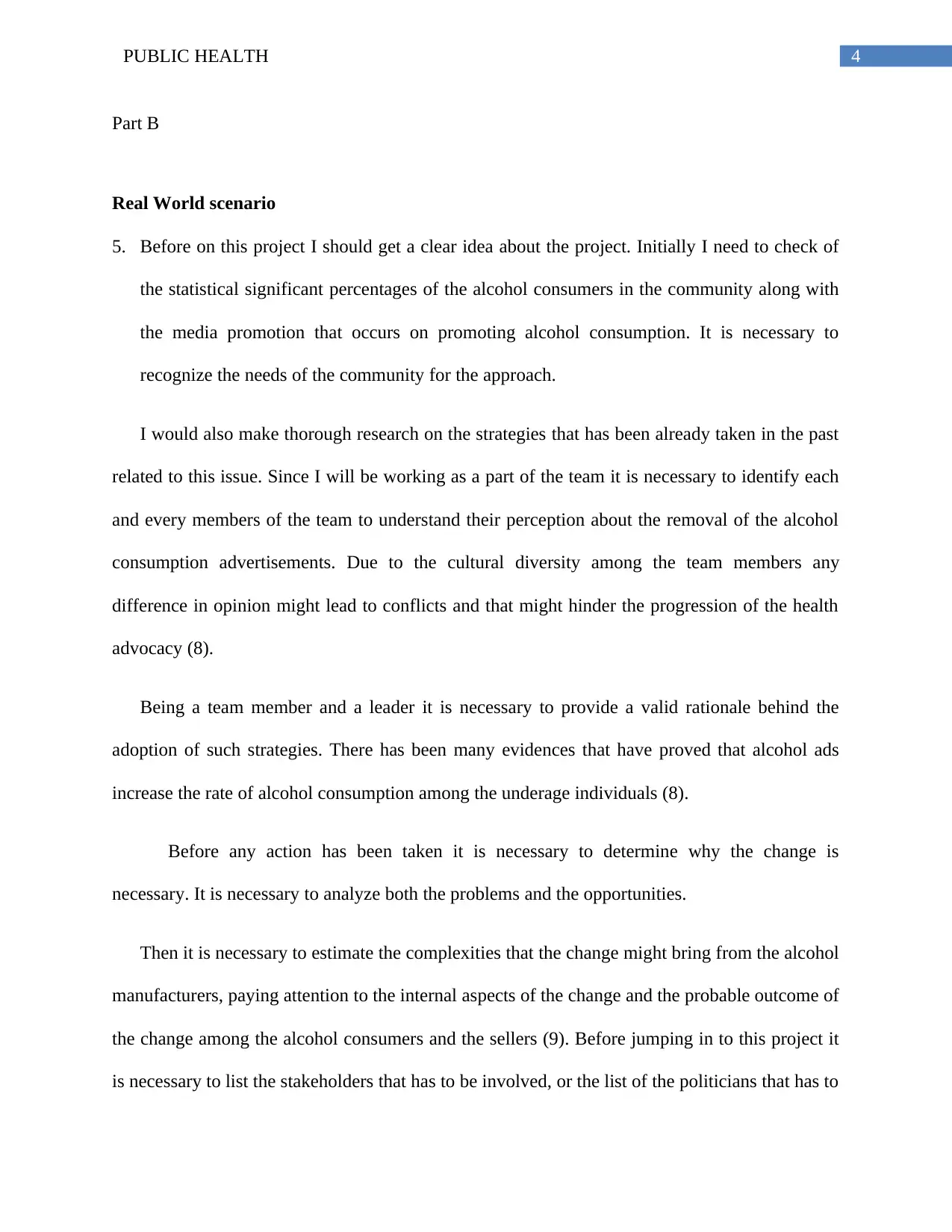
4PUBLIC HEALTH
Part B
Real World scenario
5. Before on this project I should get a clear idea about the project. Initially I need to check of
the statistical significant percentages of the alcohol consumers in the community along with
the media promotion that occurs on promoting alcohol consumption. It is necessary to
recognize the needs of the community for the approach.
I would also make thorough research on the strategies that has been already taken in the past
related to this issue. Since I will be working as a part of the team it is necessary to identify each
and every members of the team to understand their perception about the removal of the alcohol
consumption advertisements. Due to the cultural diversity among the team members any
difference in opinion might lead to conflicts and that might hinder the progression of the health
advocacy (8).
Being a team member and a leader it is necessary to provide a valid rationale behind the
adoption of such strategies. There has been many evidences that have proved that alcohol ads
increase the rate of alcohol consumption among the underage individuals (8).
Before any action has been taken it is necessary to determine why the change is
necessary. It is necessary to analyze both the problems and the opportunities.
Then it is necessary to estimate the complexities that the change might bring from the alcohol
manufacturers, paying attention to the internal aspects of the change and the probable outcome of
the change among the alcohol consumers and the sellers (9). Before jumping in to this project it
is necessary to list the stakeholders that has to be involved, or the list of the politicians that has to
Part B
Real World scenario
5. Before on this project I should get a clear idea about the project. Initially I need to check of
the statistical significant percentages of the alcohol consumers in the community along with
the media promotion that occurs on promoting alcohol consumption. It is necessary to
recognize the needs of the community for the approach.
I would also make thorough research on the strategies that has been already taken in the past
related to this issue. Since I will be working as a part of the team it is necessary to identify each
and every members of the team to understand their perception about the removal of the alcohol
consumption advertisements. Due to the cultural diversity among the team members any
difference in opinion might lead to conflicts and that might hinder the progression of the health
advocacy (8).
Being a team member and a leader it is necessary to provide a valid rationale behind the
adoption of such strategies. There has been many evidences that have proved that alcohol ads
increase the rate of alcohol consumption among the underage individuals (8).
Before any action has been taken it is necessary to determine why the change is
necessary. It is necessary to analyze both the problems and the opportunities.
Then it is necessary to estimate the complexities that the change might bring from the alcohol
manufacturers, paying attention to the internal aspects of the change and the probable outcome of
the change among the alcohol consumers and the sellers (9). Before jumping in to this project it
is necessary to list the stakeholders that has to be involved, or the list of the politicians that has to
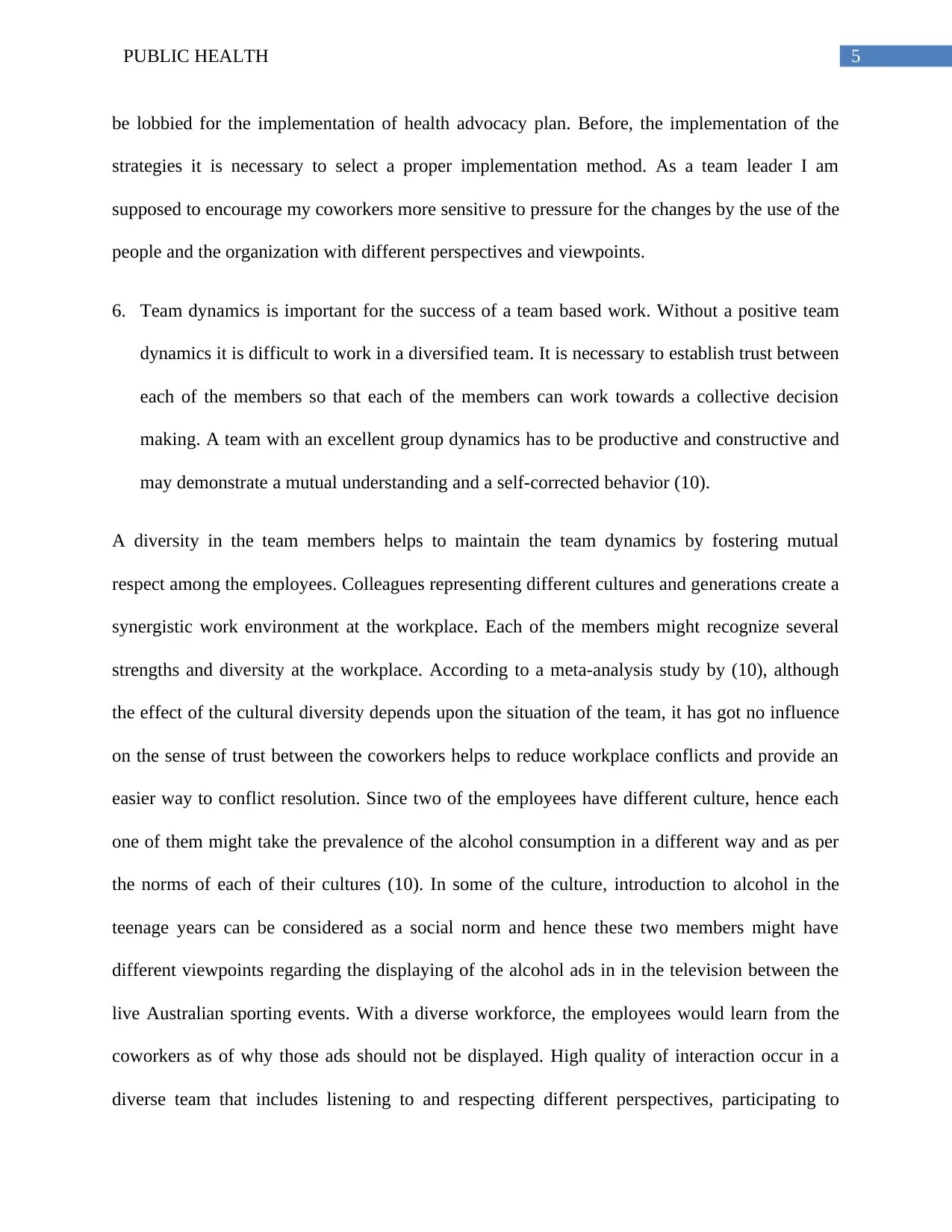
5PUBLIC HEALTH
be lobbied for the implementation of health advocacy plan. Before, the implementation of the
strategies it is necessary to select a proper implementation method. As a team leader I am
supposed to encourage my coworkers more sensitive to pressure for the changes by the use of the
people and the organization with different perspectives and viewpoints.
6. Team dynamics is important for the success of a team based work. Without a positive team
dynamics it is difficult to work in a diversified team. It is necessary to establish trust between
each of the members so that each of the members can work towards a collective decision
making. A team with an excellent group dynamics has to be productive and constructive and
may demonstrate a mutual understanding and a self-corrected behavior (10).
A diversity in the team members helps to maintain the team dynamics by fostering mutual
respect among the employees. Colleagues representing different cultures and generations create a
synergistic work environment at the workplace. Each of the members might recognize several
strengths and diversity at the workplace. According to a meta-analysis study by (10), although
the effect of the cultural diversity depends upon the situation of the team, it has got no influence
on the sense of trust between the coworkers helps to reduce workplace conflicts and provide an
easier way to conflict resolution. Since two of the employees have different culture, hence each
one of them might take the prevalence of the alcohol consumption in a different way and as per
the norms of each of their cultures (10). In some of the culture, introduction to alcohol in the
teenage years can be considered as a social norm and hence these two members might have
different viewpoints regarding the displaying of the alcohol ads in in the television between the
live Australian sporting events. With a diverse workforce, the employees would learn from the
coworkers as of why those ads should not be displayed. High quality of interaction occur in a
diverse team that includes listening to and respecting different perspectives, participating to
be lobbied for the implementation of health advocacy plan. Before, the implementation of the
strategies it is necessary to select a proper implementation method. As a team leader I am
supposed to encourage my coworkers more sensitive to pressure for the changes by the use of the
people and the organization with different perspectives and viewpoints.
6. Team dynamics is important for the success of a team based work. Without a positive team
dynamics it is difficult to work in a diversified team. It is necessary to establish trust between
each of the members so that each of the members can work towards a collective decision
making. A team with an excellent group dynamics has to be productive and constructive and
may demonstrate a mutual understanding and a self-corrected behavior (10).
A diversity in the team members helps to maintain the team dynamics by fostering mutual
respect among the employees. Colleagues representing different cultures and generations create a
synergistic work environment at the workplace. Each of the members might recognize several
strengths and diversity at the workplace. According to a meta-analysis study by (10), although
the effect of the cultural diversity depends upon the situation of the team, it has got no influence
on the sense of trust between the coworkers helps to reduce workplace conflicts and provide an
easier way to conflict resolution. Since two of the employees have different culture, hence each
one of them might take the prevalence of the alcohol consumption in a different way and as per
the norms of each of their cultures (10). In some of the culture, introduction to alcohol in the
teenage years can be considered as a social norm and hence these two members might have
different viewpoints regarding the displaying of the alcohol ads in in the television between the
live Australian sporting events. With a diverse workforce, the employees would learn from the
coworkers as of why those ads should not be displayed. High quality of interaction occur in a
diverse team that includes listening to and respecting different perspectives, participating to
⊘ This is a preview!⊘
Do you want full access?
Subscribe today to unlock all pages.

Trusted by 1+ million students worldwide
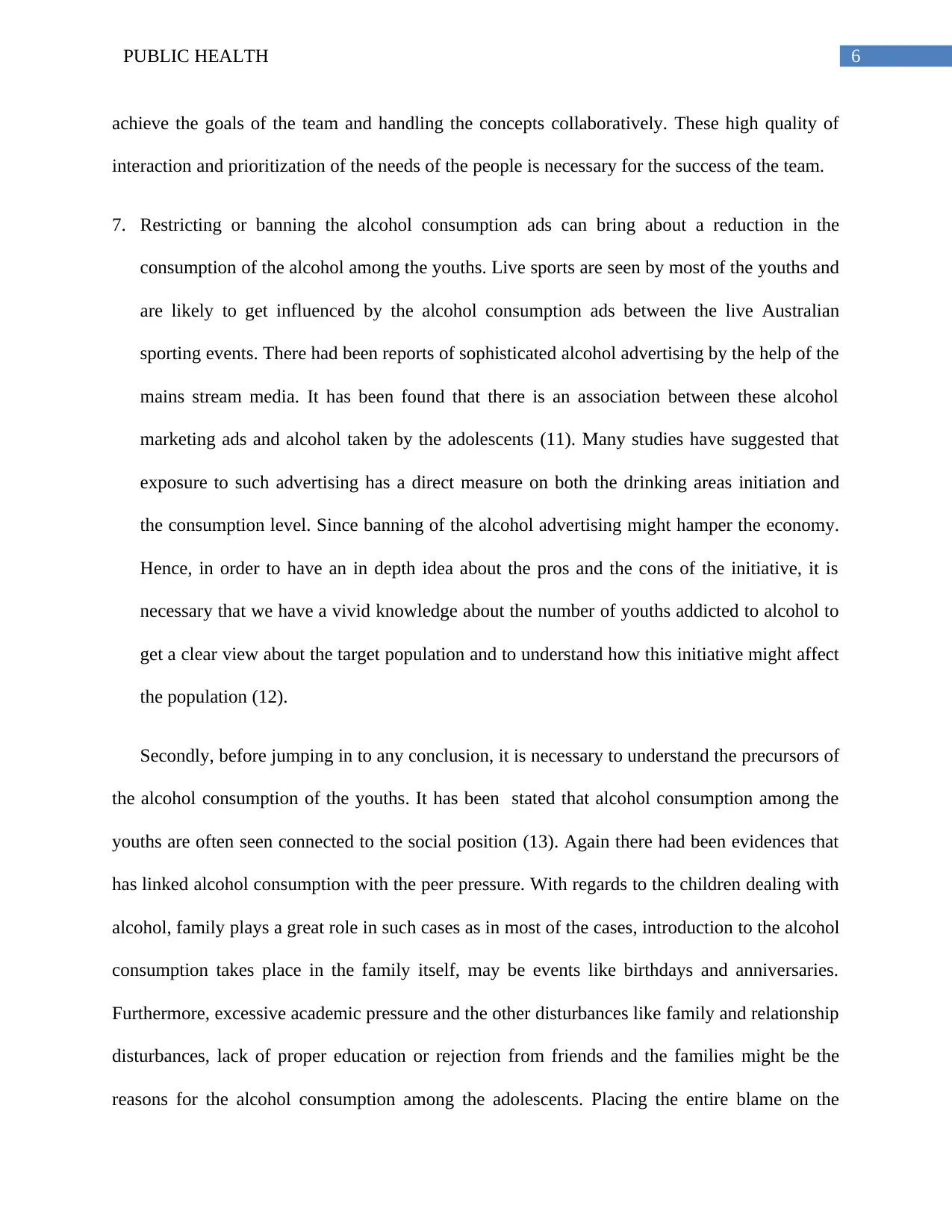
6PUBLIC HEALTH
achieve the goals of the team and handling the concepts collaboratively. These high quality of
interaction and prioritization of the needs of the people is necessary for the success of the team.
7. Restricting or banning the alcohol consumption ads can bring about a reduction in the
consumption of the alcohol among the youths. Live sports are seen by most of the youths and
are likely to get influenced by the alcohol consumption ads between the live Australian
sporting events. There had been reports of sophisticated alcohol advertising by the help of the
mains stream media. It has been found that there is an association between these alcohol
marketing ads and alcohol taken by the adolescents (11). Many studies have suggested that
exposure to such advertising has a direct measure on both the drinking areas initiation and
the consumption level. Since banning of the alcohol advertising might hamper the economy.
Hence, in order to have an in depth idea about the pros and the cons of the initiative, it is
necessary that we have a vivid knowledge about the number of youths addicted to alcohol to
get a clear view about the target population and to understand how this initiative might affect
the population (12).
Secondly, before jumping in to any conclusion, it is necessary to understand the precursors of
the alcohol consumption of the youths. It has been stated that alcohol consumption among the
youths are often seen connected to the social position (13). Again there had been evidences that
has linked alcohol consumption with the peer pressure. With regards to the children dealing with
alcohol, family plays a great role in such cases as in most of the cases, introduction to the alcohol
consumption takes place in the family itself, may be events like birthdays and anniversaries.
Furthermore, excessive academic pressure and the other disturbances like family and relationship
disturbances, lack of proper education or rejection from friends and the families might be the
reasons for the alcohol consumption among the adolescents. Placing the entire blame on the
achieve the goals of the team and handling the concepts collaboratively. These high quality of
interaction and prioritization of the needs of the people is necessary for the success of the team.
7. Restricting or banning the alcohol consumption ads can bring about a reduction in the
consumption of the alcohol among the youths. Live sports are seen by most of the youths and
are likely to get influenced by the alcohol consumption ads between the live Australian
sporting events. There had been reports of sophisticated alcohol advertising by the help of the
mains stream media. It has been found that there is an association between these alcohol
marketing ads and alcohol taken by the adolescents (11). Many studies have suggested that
exposure to such advertising has a direct measure on both the drinking areas initiation and
the consumption level. Since banning of the alcohol advertising might hamper the economy.
Hence, in order to have an in depth idea about the pros and the cons of the initiative, it is
necessary that we have a vivid knowledge about the number of youths addicted to alcohol to
get a clear view about the target population and to understand how this initiative might affect
the population (12).
Secondly, before jumping in to any conclusion, it is necessary to understand the precursors of
the alcohol consumption of the youths. It has been stated that alcohol consumption among the
youths are often seen connected to the social position (13). Again there had been evidences that
has linked alcohol consumption with the peer pressure. With regards to the children dealing with
alcohol, family plays a great role in such cases as in most of the cases, introduction to the alcohol
consumption takes place in the family itself, may be events like birthdays and anniversaries.
Furthermore, excessive academic pressure and the other disturbances like family and relationship
disturbances, lack of proper education or rejection from friends and the families might be the
reasons for the alcohol consumption among the adolescents. Placing the entire blame on the
Paraphrase This Document
Need a fresh take? Get an instant paraphrase of this document with our AI Paraphraser
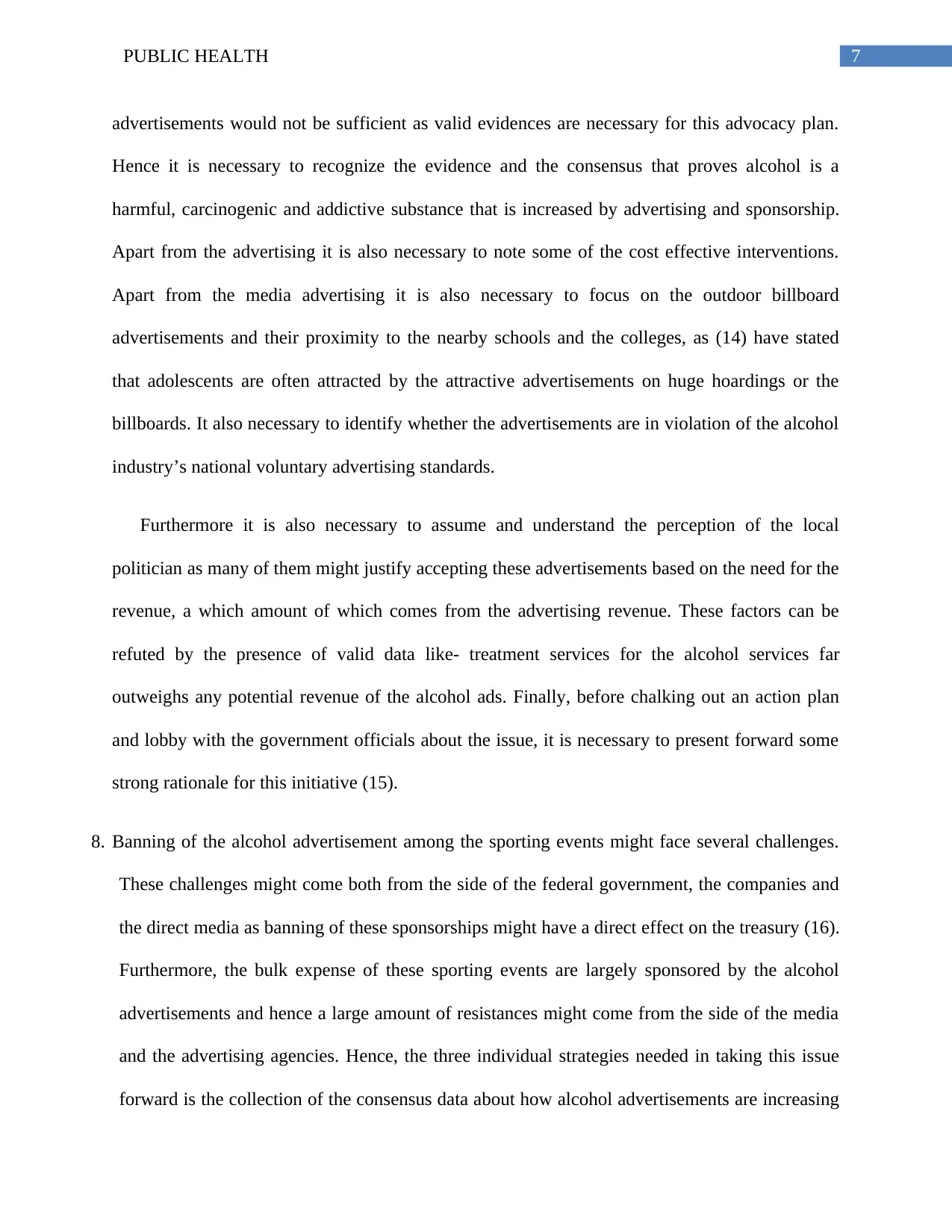
7PUBLIC HEALTH
advertisements would not be sufficient as valid evidences are necessary for this advocacy plan.
Hence it is necessary to recognize the evidence and the consensus that proves alcohol is a
harmful, carcinogenic and addictive substance that is increased by advertising and sponsorship.
Apart from the advertising it is also necessary to note some of the cost effective interventions.
Apart from the media advertising it is also necessary to focus on the outdoor billboard
advertisements and their proximity to the nearby schools and the colleges, as (14) have stated
that adolescents are often attracted by the attractive advertisements on huge hoardings or the
billboards. It also necessary to identify whether the advertisements are in violation of the alcohol
industry’s national voluntary advertising standards.
Furthermore it is also necessary to assume and understand the perception of the local
politician as many of them might justify accepting these advertisements based on the need for the
revenue, a which amount of which comes from the advertising revenue. These factors can be
refuted by the presence of valid data like- treatment services for the alcohol services far
outweighs any potential revenue of the alcohol ads. Finally, before chalking out an action plan
and lobby with the government officials about the issue, it is necessary to present forward some
strong rationale for this initiative (15).
8. Banning of the alcohol advertisement among the sporting events might face several challenges.
These challenges might come both from the side of the federal government, the companies and
the direct media as banning of these sponsorships might have a direct effect on the treasury (16).
Furthermore, the bulk expense of these sporting events are largely sponsored by the alcohol
advertisements and hence a large amount of resistances might come from the side of the media
and the advertising agencies. Hence, the three individual strategies needed in taking this issue
forward is the collection of the consensus data about how alcohol advertisements are increasing
advertisements would not be sufficient as valid evidences are necessary for this advocacy plan.
Hence it is necessary to recognize the evidence and the consensus that proves alcohol is a
harmful, carcinogenic and addictive substance that is increased by advertising and sponsorship.
Apart from the advertising it is also necessary to note some of the cost effective interventions.
Apart from the media advertising it is also necessary to focus on the outdoor billboard
advertisements and their proximity to the nearby schools and the colleges, as (14) have stated
that adolescents are often attracted by the attractive advertisements on huge hoardings or the
billboards. It also necessary to identify whether the advertisements are in violation of the alcohol
industry’s national voluntary advertising standards.
Furthermore it is also necessary to assume and understand the perception of the local
politician as many of them might justify accepting these advertisements based on the need for the
revenue, a which amount of which comes from the advertising revenue. These factors can be
refuted by the presence of valid data like- treatment services for the alcohol services far
outweighs any potential revenue of the alcohol ads. Finally, before chalking out an action plan
and lobby with the government officials about the issue, it is necessary to present forward some
strong rationale for this initiative (15).
8. Banning of the alcohol advertisement among the sporting events might face several challenges.
These challenges might come both from the side of the federal government, the companies and
the direct media as banning of these sponsorships might have a direct effect on the treasury (16).
Furthermore, the bulk expense of these sporting events are largely sponsored by the alcohol
advertisements and hence a large amount of resistances might come from the side of the media
and the advertising agencies. Hence, the three individual strategies needed in taking this issue
forward is the collection of the consensus data about how alcohol advertisements are increasing
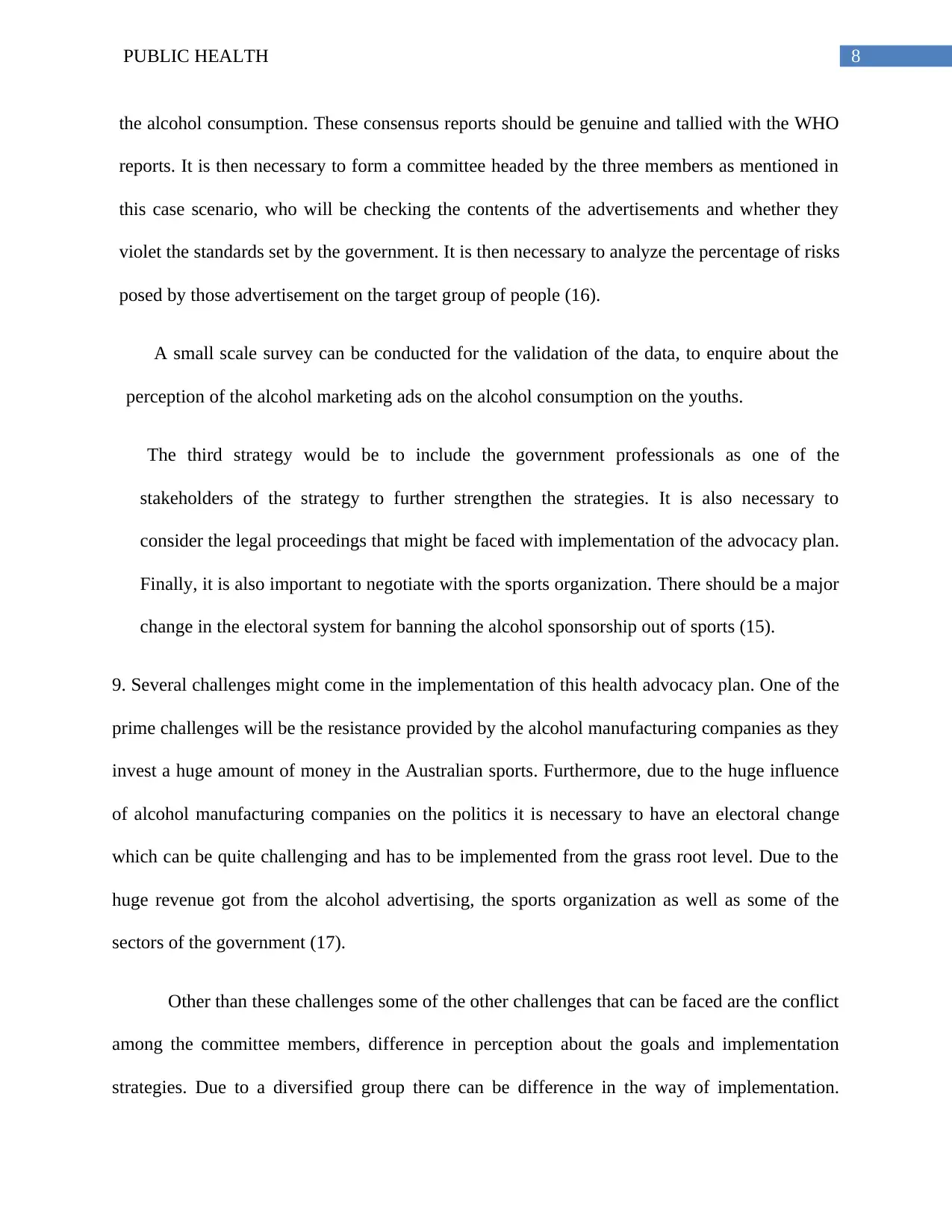
8PUBLIC HEALTH
the alcohol consumption. These consensus reports should be genuine and tallied with the WHO
reports. It is then necessary to form a committee headed by the three members as mentioned in
this case scenario, who will be checking the contents of the advertisements and whether they
violet the standards set by the government. It is then necessary to analyze the percentage of risks
posed by those advertisement on the target group of people (16).
A small scale survey can be conducted for the validation of the data, to enquire about the
perception of the alcohol marketing ads on the alcohol consumption on the youths.
The third strategy would be to include the government professionals as one of the
stakeholders of the strategy to further strengthen the strategies. It is also necessary to
consider the legal proceedings that might be faced with implementation of the advocacy plan.
Finally, it is also important to negotiate with the sports organization. There should be a major
change in the electoral system for banning the alcohol sponsorship out of sports (15).
9. Several challenges might come in the implementation of this health advocacy plan. One of the
prime challenges will be the resistance provided by the alcohol manufacturing companies as they
invest a huge amount of money in the Australian sports. Furthermore, due to the huge influence
of alcohol manufacturing companies on the politics it is necessary to have an electoral change
which can be quite challenging and has to be implemented from the grass root level. Due to the
huge revenue got from the alcohol advertising, the sports organization as well as some of the
sectors of the government (17).
Other than these challenges some of the other challenges that can be faced are the conflict
among the committee members, difference in perception about the goals and implementation
strategies. Due to a diversified group there can be difference in the way of implementation.
the alcohol consumption. These consensus reports should be genuine and tallied with the WHO
reports. It is then necessary to form a committee headed by the three members as mentioned in
this case scenario, who will be checking the contents of the advertisements and whether they
violet the standards set by the government. It is then necessary to analyze the percentage of risks
posed by those advertisement on the target group of people (16).
A small scale survey can be conducted for the validation of the data, to enquire about the
perception of the alcohol marketing ads on the alcohol consumption on the youths.
The third strategy would be to include the government professionals as one of the
stakeholders of the strategy to further strengthen the strategies. It is also necessary to
consider the legal proceedings that might be faced with implementation of the advocacy plan.
Finally, it is also important to negotiate with the sports organization. There should be a major
change in the electoral system for banning the alcohol sponsorship out of sports (15).
9. Several challenges might come in the implementation of this health advocacy plan. One of the
prime challenges will be the resistance provided by the alcohol manufacturing companies as they
invest a huge amount of money in the Australian sports. Furthermore, due to the huge influence
of alcohol manufacturing companies on the politics it is necessary to have an electoral change
which can be quite challenging and has to be implemented from the grass root level. Due to the
huge revenue got from the alcohol advertising, the sports organization as well as some of the
sectors of the government (17).
Other than these challenges some of the other challenges that can be faced are the conflict
among the committee members, difference in perception about the goals and implementation
strategies. Due to a diversified group there can be difference in the way of implementation.
⊘ This is a preview!⊘
Do you want full access?
Subscribe today to unlock all pages.

Trusted by 1+ million students worldwide
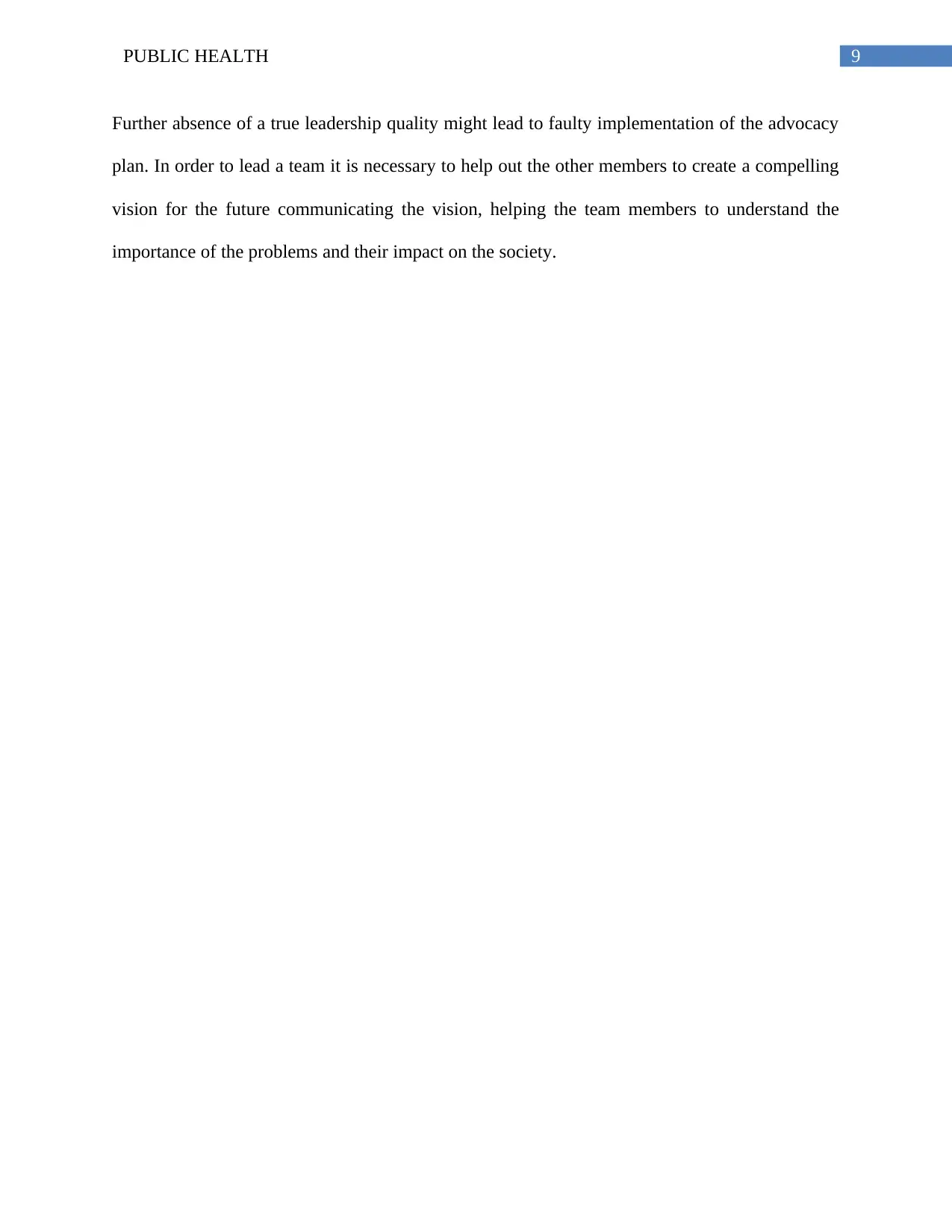
9PUBLIC HEALTH
Further absence of a true leadership quality might lead to faulty implementation of the advocacy
plan. In order to lead a team it is necessary to help out the other members to create a compelling
vision for the future communicating the vision, helping the team members to understand the
importance of the problems and their impact on the society.
Further absence of a true leadership quality might lead to faulty implementation of the advocacy
plan. In order to lead a team it is necessary to help out the other members to create a compelling
vision for the future communicating the vision, helping the team members to understand the
importance of the problems and their impact on the society.
Paraphrase This Document
Need a fresh take? Get an instant paraphrase of this document with our AI Paraphraser
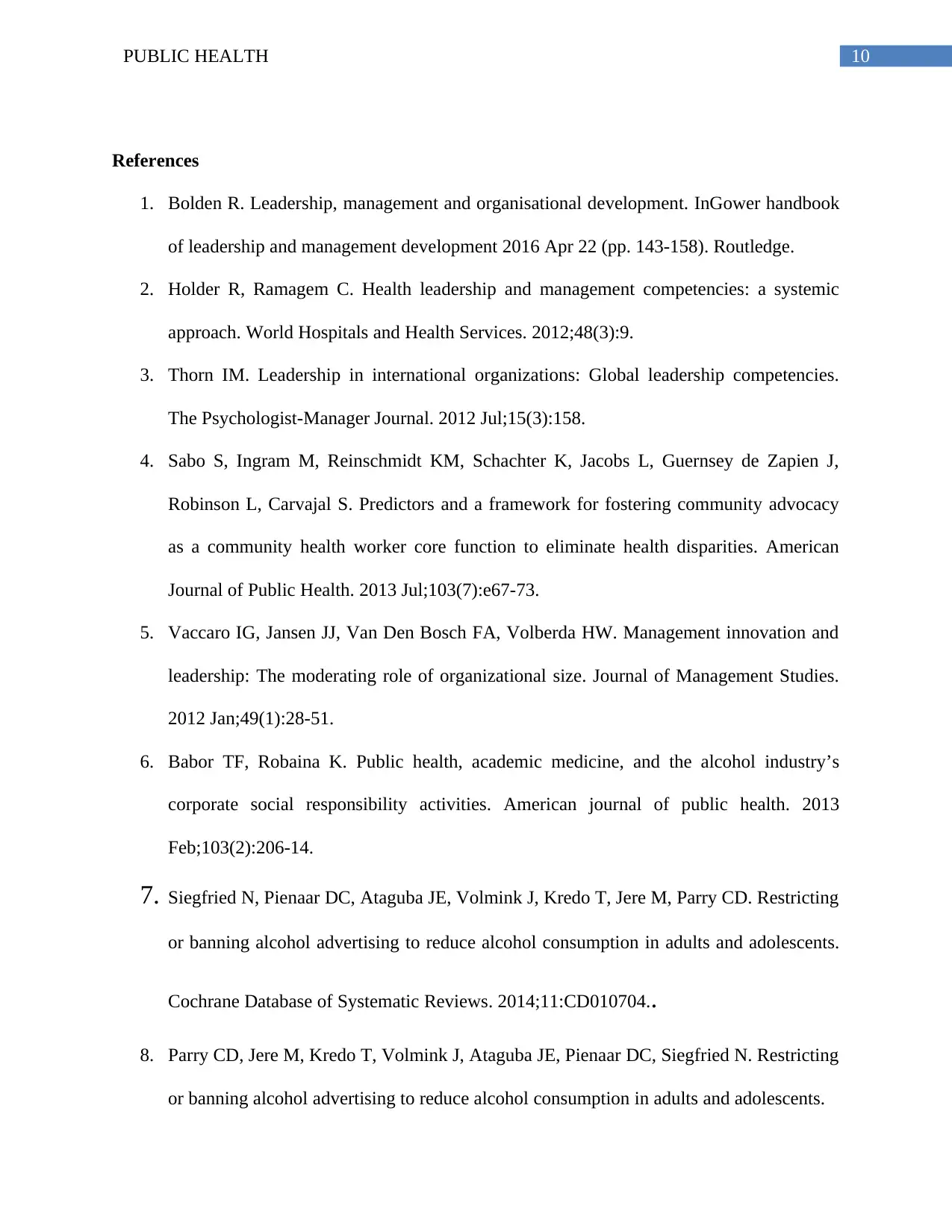
10PUBLIC HEALTH
References
1. Bolden R. Leadership, management and organisational development. InGower handbook
of leadership and management development 2016 Apr 22 (pp. 143-158). Routledge.
2. Holder R, Ramagem C. Health leadership and management competencies: a systemic
approach. World Hospitals and Health Services. 2012;48(3):9.
3. Thorn IM. Leadership in international organizations: Global leadership competencies.
The Psychologist-Manager Journal. 2012 Jul;15(3):158.
4. Sabo S, Ingram M, Reinschmidt KM, Schachter K, Jacobs L, Guernsey de Zapien J,
Robinson L, Carvajal S. Predictors and a framework for fostering community advocacy
as a community health worker core function to eliminate health disparities. American
Journal of Public Health. 2013 Jul;103(7):e67-73.
5. Vaccaro IG, Jansen JJ, Van Den Bosch FA, Volberda HW. Management innovation and
leadership: The moderating role of organizational size. Journal of Management Studies.
2012 Jan;49(1):28-51.
6. Babor TF, Robaina K. Public health, academic medicine, and the alcohol industry’s
corporate social responsibility activities. American journal of public health. 2013
Feb;103(2):206-14.
7. Siegfried N, Pienaar DC, Ataguba JE, Volmink J, Kredo T, Jere M, Parry CD. Restricting
or banning alcohol advertising to reduce alcohol consumption in adults and adolescents.
Cochrane Database of Systematic Reviews. 2014;11:CD010704..
8. Parry CD, Jere M, Kredo T, Volmink J, Ataguba JE, Pienaar DC, Siegfried N. Restricting
or banning alcohol advertising to reduce alcohol consumption in adults and adolescents.
References
1. Bolden R. Leadership, management and organisational development. InGower handbook
of leadership and management development 2016 Apr 22 (pp. 143-158). Routledge.
2. Holder R, Ramagem C. Health leadership and management competencies: a systemic
approach. World Hospitals and Health Services. 2012;48(3):9.
3. Thorn IM. Leadership in international organizations: Global leadership competencies.
The Psychologist-Manager Journal. 2012 Jul;15(3):158.
4. Sabo S, Ingram M, Reinschmidt KM, Schachter K, Jacobs L, Guernsey de Zapien J,
Robinson L, Carvajal S. Predictors and a framework for fostering community advocacy
as a community health worker core function to eliminate health disparities. American
Journal of Public Health. 2013 Jul;103(7):e67-73.
5. Vaccaro IG, Jansen JJ, Van Den Bosch FA, Volberda HW. Management innovation and
leadership: The moderating role of organizational size. Journal of Management Studies.
2012 Jan;49(1):28-51.
6. Babor TF, Robaina K. Public health, academic medicine, and the alcohol industry’s
corporate social responsibility activities. American journal of public health. 2013
Feb;103(2):206-14.
7. Siegfried N, Pienaar DC, Ataguba JE, Volmink J, Kredo T, Jere M, Parry CD. Restricting
or banning alcohol advertising to reduce alcohol consumption in adults and adolescents.
Cochrane Database of Systematic Reviews. 2014;11:CD010704..
8. Parry CD, Jere M, Kredo T, Volmink J, Ataguba JE, Pienaar DC, Siegfried N. Restricting
or banning alcohol advertising to reduce alcohol consumption in adults and adolescents.
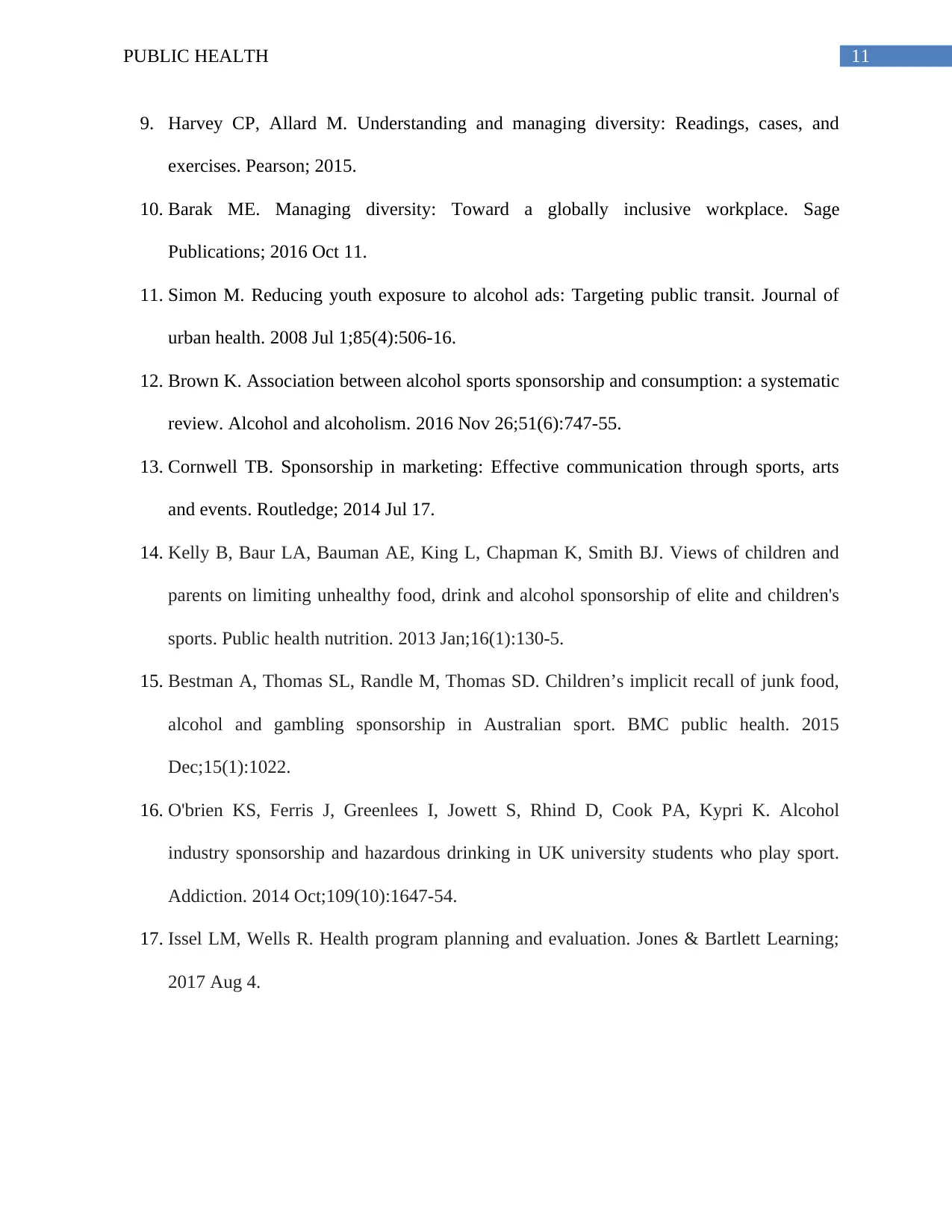
11PUBLIC HEALTH
9. Harvey CP, Allard M. Understanding and managing diversity: Readings, cases, and
exercises. Pearson; 2015.
10. Barak ME. Managing diversity: Toward a globally inclusive workplace. Sage
Publications; 2016 Oct 11.
11. Simon M. Reducing youth exposure to alcohol ads: Targeting public transit. Journal of
urban health. 2008 Jul 1;85(4):506-16.
12. Brown K. Association between alcohol sports sponsorship and consumption: a systematic
review. Alcohol and alcoholism. 2016 Nov 26;51(6):747-55.
13. Cornwell TB. Sponsorship in marketing: Effective communication through sports, arts
and events. Routledge; 2014 Jul 17.
14. Kelly B, Baur LA, Bauman AE, King L, Chapman K, Smith BJ. Views of children and
parents on limiting unhealthy food, drink and alcohol sponsorship of elite and children's
sports. Public health nutrition. 2013 Jan;16(1):130-5.
15. Bestman A, Thomas SL, Randle M, Thomas SD. Children’s implicit recall of junk food,
alcohol and gambling sponsorship in Australian sport. BMC public health. 2015
Dec;15(1):1022.
16. O'brien KS, Ferris J, Greenlees I, Jowett S, Rhind D, Cook PA, Kypri K. Alcohol
industry sponsorship and hazardous drinking in UK university students who play sport.
Addiction. 2014 Oct;109(10):1647-54.
17. Issel LM, Wells R. Health program planning and evaluation. Jones & Bartlett Learning;
2017 Aug 4.
9. Harvey CP, Allard M. Understanding and managing diversity: Readings, cases, and
exercises. Pearson; 2015.
10. Barak ME. Managing diversity: Toward a globally inclusive workplace. Sage
Publications; 2016 Oct 11.
11. Simon M. Reducing youth exposure to alcohol ads: Targeting public transit. Journal of
urban health. 2008 Jul 1;85(4):506-16.
12. Brown K. Association between alcohol sports sponsorship and consumption: a systematic
review. Alcohol and alcoholism. 2016 Nov 26;51(6):747-55.
13. Cornwell TB. Sponsorship in marketing: Effective communication through sports, arts
and events. Routledge; 2014 Jul 17.
14. Kelly B, Baur LA, Bauman AE, King L, Chapman K, Smith BJ. Views of children and
parents on limiting unhealthy food, drink and alcohol sponsorship of elite and children's
sports. Public health nutrition. 2013 Jan;16(1):130-5.
15. Bestman A, Thomas SL, Randle M, Thomas SD. Children’s implicit recall of junk food,
alcohol and gambling sponsorship in Australian sport. BMC public health. 2015
Dec;15(1):1022.
16. O'brien KS, Ferris J, Greenlees I, Jowett S, Rhind D, Cook PA, Kypri K. Alcohol
industry sponsorship and hazardous drinking in UK university students who play sport.
Addiction. 2014 Oct;109(10):1647-54.
17. Issel LM, Wells R. Health program planning and evaluation. Jones & Bartlett Learning;
2017 Aug 4.
⊘ This is a preview!⊘
Do you want full access?
Subscribe today to unlock all pages.

Trusted by 1+ million students worldwide
1 out of 12
Related Documents
Your All-in-One AI-Powered Toolkit for Academic Success.
+13062052269
info@desklib.com
Available 24*7 on WhatsApp / Email
![[object Object]](/_next/static/media/star-bottom.7253800d.svg)
Unlock your academic potential
Copyright © 2020–2025 A2Z Services. All Rights Reserved. Developed and managed by ZUCOL.





